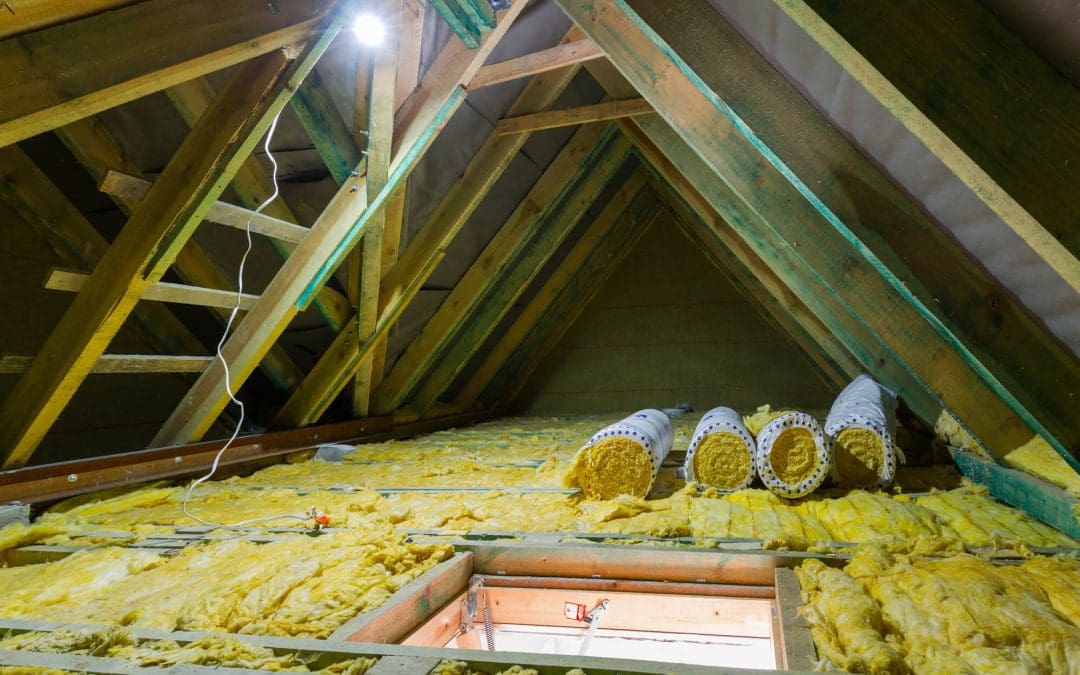Proper attic insulation is one of the best ways to improve your home’s energy efficiency. It is crucial because it regulates your home’s temperature, keeping it warm in the winter and cool in the summer, and even reduces your energy bills. Whether you’re building a new home or want to improve your house’s energy efficiency, adequate attic insulation is a must. Let’s go over the different types and their benefits.
Fiberglass Insulation
One of the most common types of attic insulation is fiberglass. This material is made from fine glass fibers and is available in batts or rolls, which are easy to install between attic joists. Fiberglass is popular because it’s cost-effective and has a high R-value per inch, which measures thermal resistance. It’s also resistant to moisture and doesn’t settle over time.
When installing fiberglass, wearing protective gear is crucial, as the tiny glass particles irritate the skin and lungs. Proper installation is key to avoiding gaps and compression so it remains effective.
Eco-Friendly Attic Insulation: Cellulose
Cellulose insulation is made from recycled paper products, mostly newspaper, and is treated with fire retardants. It’s an eco-friendly option that is good for environmentally conscious homeowners. Cellulose is installed using a blowing machine and is excellent for filling in nooks and crannies in your attic, providing a tight air seal.
This type of insulation has a higher R-value per inch than fiberglass and is better at blocking air leaks. It’s particularly useful in attics with irregular spacing between joists. It’s heavier than fiberglass, which may be a concern in older homes with weaker structural supports.
Foam Insulation
Foam insulation includes two main types: spray foam and rigid foam boards. Spray foam expands to fill cavities and cracks, providing an excellent air barrier. It comes in two forms: open-cell and closed-cell. Closed-cell has a higher R-value and moisture barrier.
Rigid foam boards are great for insulating flat surfaces and can be cut to fit around beams and braces. These boards are often used with other insulation types to achieve a higher R-value and airtight seal.
Foam insulation is more expensive than fiberglass or cellulose but offers better air sealing and moisture resistance, which is especially beneficial in extreme climates.
Mineral Wool
Also known as rock wool or slag wool, mineral wool is made from molten rock, steel slag, or ceramics spun into fiber. It is denser than fiberglass and cellulose and has great fire resistance, making it a good choice for sound reduction and thermal performance.
Mineral wool is naturally moisture-resistant and doesn’t require additional fire-retardant treatments, but its higher cost and weight might be a drawback for some projects.
Reflective Insulation
Reflective insulation, or radiant barriers, works differently from other insulating materials. Instead of slowing heat transfer, they reflect radiant heat away from your home. This type of insulation is usually made from aluminum foil attached to paper or plastic and is particularly effective in hot climates.
While not a substitute for other types of insulation, reflective insulation is an excellent supplement to reduce cooling costs in the summer. It’s most effective when installed with a small air gap facing the open air.
Understanding and choosing the right attic insulation will maximize comfort, reduce energy costs, and improve the overall performance of your home. With this information, you will make an informed decision that meets your needs and budget.
FAQs About Attic Insulation
How do I know which type of insulation is best for my attic?
The best insulation for your attic depends on several factors, including your climate, the current state of your attic, local building codes, and your budget. Consult with a professional who will provide a solution for you.
Can I install attic insulation myself?
Some types of insulation, like fiberglass batts, are suitable for DIY if you take proper precautions. However, due to the chemicals involved and the expertise required for correct installation, professionals should install materials like spray foam.
How much does attic insulation cost?
Costs vary widely based on the material type and the size of your attic. Fiberglass insulation is usually the most cost-effective, with foam being on the higher end of the spectrum.
Does adding more insulation always improve energy efficiency?
Yes, adding insulation will improve energy efficiency up to a certain point. However, after reaching an optimal level (which varies by location and home design), additional insulation will not affect energy efficiency.
House Doctor Home Inspection offers inspection services to customers in Rhode Island. Contact us to request an appointment.

